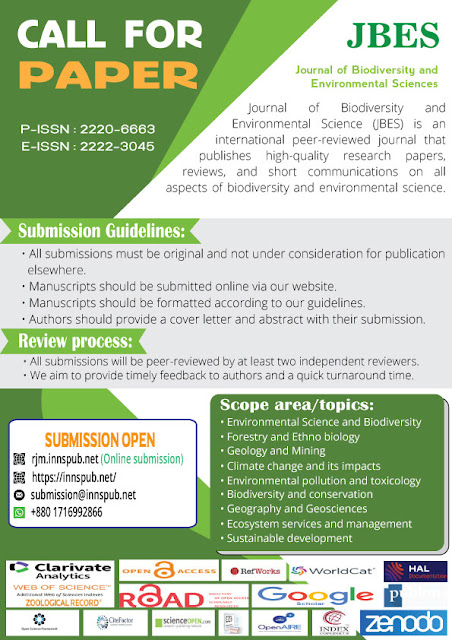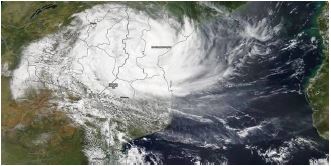Ratnawati Ratnawati,
Arfan Arfan, Kasman Jaya, Sri Sudewi, and Mr. Mufida, from the different
institute of the Indonesia. wrote a research article about, Trichoderma
asperellum TR3 Viability Formulation: Packaging Variations. entitled, Viability
formulation with active Trichoderma asperellum TR3 in three packaging variation.
This research paper published by the International journal of Microbiology and
Mycology (IJMM). an open access scholarly research journal on Microbiology. under
the affiliation of the International Network For Natural Sciences |
NNSpub. an open access multidisciplinary research journal publisher.
Abstract
Trichoderma asperellum TR3
has been applied as a biopesticide and Plant Growth Promotion Fungi (PGPF) but
in the form of a suspension and substrate without the addition of carriers and
adhesives so for long-term use and short shelf life. This study aims to obtain
the right packaging formulation and have good viability, as well as a long
storage time using talc and tapioca flour as the basic ingredients. The isolate
collection was rejuvenated by growing in PDA medium, after completion of
incubation for 48 hours, the growing fungal colonies were counted, isolated and
purified, then made in the form of a powder starter. Test of various
formulations of T. asperellum TR3 fungal powder packaging was carried
out by viability test using a Completely Randomized Design (CRD), with
packaging treatment on the formulation: P1 = Aluminum foil plastic, P2 = Bottle
and P3 = Cetic plastic. Each treatment was repeated 3 times to obtain a
combination of 9 treatment units. Furthermore, all packaging combinations were
stored at room temperature. In the first month, 1 pack was taken for regrowth
which aims to determine the viability of the conidia and then every two weeks
for 12 weeks. The results showed that the average number of conidia colonies
growing on various packages gave different viability results, but had no
significant effect between formulations of various packages and viability. The average
number of colonies that grew on aluminum foil plastic packaging was more in
each observation of storage time compared to bottle and plastic packaging.
Introduction
The use of
microorganisms as biological control agents has been widely carried out and
provides benefits for increasing agricultural production in Indonesia (Hanudin
and Marwoto 2012; Nur Amin et al., 2015; Ratna et al., 2020; Ratnawati et al.,
2020). However, reports on the use of local or local microorganisms that have
potential have not been widely carried out. Local microorganisms work more
effectively, because they are supported by various appropriate environmental
factors and do not result in ecosystem changes and implementation in the field
is easier. According to Cook & Baker (1983), efforts to overcome plant
diseases with biological practices provide good opportunities because the
microorganisms are already available in the field and their activities can be
controlled by the environment and the host.
The group of
microorganisms, especially fungal microbes that are able to suppress pathogens,
is in the Moniliales family, such as Verticillum sp., Trichoderma sp and
Gliocladium sp. The genus Trichoderma sp. it is known that several species can
parasitize other fungi and have the potential to be used as biological control
(Santoso et al., 2007; Ratnawati et al., 2019; Ratnawati et al., 2020).
Microbes that are
useful as components of natural habitats have important roles and functions in
supporting the implementation of environmentally friendly agriculture through
various processes such as decomposition of organic matter, mineralization of
organic matter, besides that microbes are positioned as producers of nutrients
for plants. Budiarti & Nurhayati (2014), reported that plants and microbes
will interact and stimulate each other caused by the presence of root exudates.
Fungi are heterotrophs, dominant on acid soils although they are also found in
neutral or alkaline soils and some of them are sensitive to pH 9.0 but this
sensitivity is important in overcoming plant diseases. The presence of fungi
and bacteria as antagonist agents is able to influence the activity of
microorganisms so that it is important to take into account the suppression of
disease. In addition, many antagonist agents can stimulate plant growth because
they are able to produce growth hormones, fix nitrogen, dissolve phosphate, and
produce siderophores (Siti Hardiyanti et al., 2017).
Antagonistic microbes
found in the rhizosphere and rhizoplan areas that can act as controlling agents
include the genus Trichoderma sp, Penicillium sp and Asperigillus sp (Agrios.,
2005), while Nirwanto & Mujoka (2009) reported that the microbes found in
the phyllosphere were the genus Penicillium sp., Fusarium sp. , Trichoderma sp.
, Stemphylium sp., Rhizopus sp., Curvularia sp. and Gliocladium sp.
Furthermore, Sayang (2009) reported that microbial antagonists that are
effective as biological controllers include Bacillus sp, Trichoderma sp,
Penicillium sp and Clostridium sp.
Nur Amin et al. (2015)
suggested that the application of non-pathogenic fungi to various types of
plants would increase the resistance of the host plant to pathogen attack and
be able to induce resistance in the upper part of the plant. The use of
beneficial microbes in improving soil texture and structure by increasing its
aggregation and stability (Rashid et al., 2016). The interaction between
microbes and plants is an indicator of soil fertility (Hayat et al., 2010).
Many studies using the
fungus Trichoderma sp. as an effective biological agent to control various
pathogens, however, it is still experiencing obstacles related to storage time
(Suhera et al., 2018). Trichoderma sp. is a group of fungi that are always
associated with plants and soil. If this fungus is in plant tissue, it is
called an endophytic fungus (Nur Amin et al., 2017). Trichoderma sp. is one of
the endophytic fungi that can live in all parts of plant tissue both below
ground and above ground, namely roots, stems and leaves (Kusari et al., 2012;
Rosmana et al., 2018).
Ratnawati's previous
research (2020) was in vitro starting from the microbial isolation stage,
identification of microbes both macroscopically and microscopically, microbial
screening, molecular identification, compatibility tests, antagonist tests,
until superior and potential microbes were found as biopesticides and as plant
growth microbes. Promotion Fungi (PGPF) obtained as many as 9 microbes that
could potentially be used as biological agents. One of them is Trichoderma
asperellum TR3.
Trichoderma asperellum
TR3 is one of the rhizosphere fungi which is known as an antagonist fungus in
both in vitro and in vivo tests which has the ability to suppress various types
of pathogens in various plants. T.asperellum TR3 is a fungus with biopesticide
and PGPF properties (Suhera 2018; Ratnawati et al., 2020; Ismail et al., 2020).
T. asperellum (TR3) has been applied as a biopesticide and PGPF but in the form
of a suspension and substrate without the addition of carriers and adhesives so
that it is for long term use and has a short shelf life. Therefore, it is
necessary to develop a formulation in powder form with various forms of
packaging which will then be monitored for viability during storage.
Based on the
description above, it is necessary to conduct research on the development of
powder formulations of the fungus T.asperellum strain TR3 isolate in various
forms of packaging formulations to determine the viability of the fungal
formulation. This study aims to obtain the right packaging formulation and have
good viability, with a duration of storage.
Reference
Agrios NA. 2005.
Plant Pathology. Fifth Edition. Academic Press. San Diego, California.
Budiarti L, dan
Nurhayati. 2014. Kelimpahan Cendawan Antagonis pada Rhizosfer Tanaman
Kacang Panjang (Vigna sinensis L) Savi ex Hassk di Lahan Kering Indralayah
Sumatera Selatan. Prosiding seminar Nasional Lahan Suboptimal Palembang.
ISBN:979-587-529-9
Cook RJ, Dan Baker KF. 1983.
The nature and practice of biological control of plant pathogens, APA Press the
American Phytopathological Society. St. Paul, Minnesota.
Hanudin dan Budi
Marwoto. 2012. Prospek Penggunaan Mikroba Antagonis Sebagai Agens
Pengendali Hayati Penyakit Utama Pada Tanaman Hias Dan Sayuran, Jurnal Litban
Pertanian Vol. 3(1)
Hayat RS, Ali U, Amara
R, Khalid, Ahmed I. 2010. Soil beneficial bacteria and their role in Plan
Growth Promotion: A Review Ann. Microbiol 60(4), 579-598.
Kusari S, Verma VC,
Lamshoeft M, Spiteller M. 2012. An endophytic fungus from Azadirachta
indica juss that produces azadirachtin. World J. Microbiol
Biotechnol 28, 1287-1294.
Loves-Arevelo AG,
Huerta-Palacios, Sanches-Vazquez JE. 1996. Comtamination Encountered uring
Various Phase of Cultivation of Pleurotus ostreatus in Tropical
Mexico. Mushroom Biology and Mushroom Product, Royse (De.) Penn State
University P: 495-501
Ismail M, Ade Rosmana,
Sylvia jam dan Ratnawati. 2020. shallot Basal Bulb Rot Management through
Integration of Trichoderma asperellum, Composted Plant Residues and
Natural Mulch. Journal Pure Appl Microbiol | 14(3), 1779-1788.
Nirwanto H, Dan Mujoka
T. 2009. Eksplorasi dan kajian Keragaman Jamur Filoplen pada Tanaman
Bawang Merah: Upaya Pengendalian Hayati Terhadap Penyakit Bercak Ungu (Alternaria
porii). Bahan Seminar Nasional Pada Fak.Pertanian dan LPMM UPM Veteran Jawa
Timur.
Novita E, Purbasari D,
Mubarok MSM. 2021. Pendugaan Umur Simpan Bubuk Kopi Arabika Menggunakan
Metode Arrhenius dengan Kemasan Aluminium Foil dan Plastik (Polipropilen).
Jurnal Teknik Pertanian Lampung 10(3), 392-401.
Nur Amin, Muslim Salam,
Asman, Ryan, Danial Rahim. 2015. Investigation of Endophytic Fungi
towards Vascular Streick Dieback Oncobasidium theobromae on Seedling
of Cocoa Plant. Journal of Applied Biological Sciences 9(2), 86-89.
Nur Amin, La Daha, Nurariaty
Agus. 2017. Endophytic Fungi as Biopesticide Againts Rice Black Bug on
Rice Plant. Research Journal of Pharmaceutical, Biological and Chemical
Sciences 8(2).
Rashid MI, Mujawar LH,
Shahzad T, Almeelbi T, Ismai IMI. 2016. Bacteria and fungi cams contribute
to nutrients bioavailability and aggregate formation in degrade soils.
Microbiol. Res.183, 26-41.
Ratna Sari Dewi,
Giyanto, Meity Suradji Sinaga, Dadang dan Bambang Nuryanto. 2020. Bakteri
Agens Hayati Potensial terhadap Patogen Penting pada Padi, Jurnal
Fitofatologi 16(1), 37-48
Ratnawati, Sylvia Sjam,
Ade Rosmana dan Untung Surapati Tresnaputra. 2019. Impact of Pesticides on
the Diversity of Fungi at Local Shallot in Palu, Indonesia. Int. J. Curr.
Microbiol. App. Sci. 8(8), 730-738
Ratnawati R, Sylvia
Sjam, Ade Rosmana dan Untung Surapati Tresnaputra. 2020. Endophytic
Trichoderma Species of Palu Valley Shallot Origin with Potential for
Controlling Purple Blotch Pathogen Alternaria pori. International Journal of
Agriculture and Biology 23(05), 977-982.
Ratnawati dan K
Jaya. 2021. Seleksi Dan Identifikasi Cendawan Endofit Di Pertanaman
Organik Bawang Merah Lokal Palu. Jurnal Agrotech 11(1), 13-19, Juni
2021
Rosmana A, Sylvia Sjam,
Asman Asman, Nurul Jihad Jayanti, Satriana Satriana, Andi Tenri Padang, Andi
Akbar Hakkar. 2018. Systemic Deployment of Trichoderma asperellum in Theobrama
cacao Regulator Co-occuring Dominant Fungal Endophytes Colonization.
Journal of Pure and Applied Microbiology 12(3), 1071-1084.
Sayang Y. 2009.
Kajian Keragaman Mikoba Antagonis Rizosfer Dan Pemanfaatannya dalam
Mengedalikan Penyebab Penyakit Busuk Umbi (Fusarium oxysporum Schecht) Pada
Tanaman Bawang Merah. Jurnal Sains & Teknologi 9(3), 165-170.
Santoso SE, Soesanto L,
dan Dwi Haryanto TA. 2007. Penekanan Hayati Penyakit Moler Pada Bawang
Merah Dengan Trichoderma harzianum, Trichoderma koningii, dan Pseudomonas
fluorescens P60. J. HPT Tropika 7(1), 53-61.
Siti Hadiyanti, Bonny
Purnumo, Wahyu Soekarno dan Titek Siti Yuliani. 2017. Kemampuan Mikroba
Endofit dan Risosfer Tanaman Karet dalam Mengendalikan Rigidoporus
lignosus. Jurnal Fitopatologi Indonesia 13(5), 153-160.
Suherah, Tutik
Kuswinanti, Ade Rosmana dan Burhanuddin Rasyid. 2018. The Effect Of
Organic Medium Use In Formulation Of Trichoderma Harzianum and Pleurotus
Ostreatus In Viability And Decomposition Of Cacao Pod Husks Waste. J.
Biotechnol 15(1), 107-112.









.JPG)

%20A.%20Turex%20WP%20B.%20Cutlass%20WP%20C.%20Delfin%20WDG..JPG)

%20healthy%20insect,%20(B,%20C,%20D)%20death%20insect..JPG)













%20in%20full.JPG)

